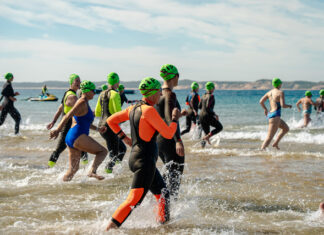Andrew Mathieson
BIG Bob Wiltshire limps slowly into the dining room, crutches guiding the ageing 77-year-old to the comfort of a waiting chair.
He casts a broken figure after buckling his knee badly in a recent truck accident.
It confines him to isolation upstairs – wife Pauline by his side – on a smaller acreage on the outskirts of residential Waurn Ponds.
Just a few hundred metres down the road is the fertiliser business that bears Bob’s name but, with a tinge of regret, he accepts his latest injury has probably curtailed his working days.
“And now I have to go for my truck licence again,” he mutters under his breath.
It’s a far cry from the exuberance that has marked a colourful life.
Once Geelong’s tallest ever VFL player, his Big Bob nickname, or sometimes just Mr Big, has stuck past the 30 matches he played for the Cats after their 1951 and ‘52 premierships. He played a further 36 for North Melbourne on the lure of 10 pounds a game.
But the real larrikin came out after his VFL career when Bob discovered fun like sheaf tossing and tug-o-war, even beating Italian immigrants in spaghetti-eating contests.
“I think they let me win,” Bob jokes.
Bob’s bulging eyes, protruding chin and boorish smile helped build his larger-than-life public persona in his heyday.
“A newspaper cartoonist once told him he was the easiest face to draw,” Pauline points out.
Bigger even than Bob’s distinctive facial characteristics was his sheer size.
At 13, he stood 159cm, or 5’3” on the old-scale, before growing to a man-size 185cm, or 6’1”, in just 12 months.
He went from a speedy wingman into the ruck by season’s end.
Arriving at Kardinia Park in 1953, Bob stood over his teammates when ruckmen were more akin to followers of the play rather than giants in the centre.
“These days I’d be a half-back flanker, though,” Bob insists, laughing.
Only Essendon’s ruck stocks of Geoff Leek and John Gill were marginally taller in the VFL of the era.
Bob’s growth spurt coincided with his family’s move from the arid Sunraysia region in northern Victoria to wet Gippsland in the south.
“I always say I felt like a plant being watered and that’s why I grew there,” he says.
“That’s the first time I ever saw wet grounds.”
Footy talent scouts years later had heard of Bob towering over rivals in the bush. They travelled to Foster where they saw him kick one goal and 17 points in a tight win.
Faster with his wit than accurate with his feet, the gift of the gab served Bob well in his dealings with the recruiters.
“I told them that I won the game for them with all those points,” Bob nods, “it was worth four goals in the wet.”
Before Billy Brownless kicked a football over a silo, Bob was flinging haystacks over his shoulder – and pretty far, as well, while breaking every sheaf-tossing record.
The traditional Scottish highland game involves around 7kg of straw bundled together and hurled as far as possible with a pitchfork.
One of Bob’s attempts in 1956 travelled over 28.5 metres for a new Guinness Book of Records entry back when they mattered and nearly every home had a copy on its bookshelf.
“In those days it was a big deal,” Bob remarks.
“You were pretty famous – nearly more than footy.
“It was always a bit of fun – I never took it too seriously.”
Bob’s casual approach extended to tug-o-war battles in which his huge frame was perfectly suited to the position of anchorman.
His champion Werribee team had 147 wins from 150 contests.
And the secret to his success?
“I always performed better on a warm beer,” Bob grins.
Get the latest news to your email inbox FREE!
REGISTER





